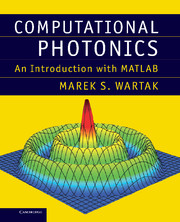Book contents
- Frontmatter
- Contents
- Preface
- 1 Introduction
- 2 Basic facts about optics
- 3 Basic facts from electromagnetism
- 4 Slab waveguides
- 5 Linear optical fibre and signal degradation
- 6 Propagation of linear pulses
- 7 Optical sources
- 8 Optical amplifiers and EDFA
- 9 Semiconductor optical amplifiers (SOA)
- 10 Optical receivers
- 11 Finite difference time domain (FDTD) formulation
- 12 Beam propagation method (BPM)
- 13 Some wavelength division multiplexing (WDM) devices
- 14 Optical link
- 15 Optical solitons
- 16 Solar cells
- 17 Metamaterials
- Appendix A Basic MATLAB
- Appendix B Summary of basic numerical methods
- Index
8 - Optical amplifiers and EDFA
Published online by Cambridge University Press: 05 July 2013
- Frontmatter
- Contents
- Preface
- 1 Introduction
- 2 Basic facts about optics
- 3 Basic facts from electromagnetism
- 4 Slab waveguides
- 5 Linear optical fibre and signal degradation
- 6 Propagation of linear pulses
- 7 Optical sources
- 8 Optical amplifiers and EDFA
- 9 Semiconductor optical amplifiers (SOA)
- 10 Optical receivers
- 11 Finite difference time domain (FDTD) formulation
- 12 Beam propagation method (BPM)
- 13 Some wavelength division multiplexing (WDM) devices
- 14 Optical link
- 15 Optical solitons
- 16 Solar cells
- 17 Metamaterials
- Appendix A Basic MATLAB
- Appendix B Summary of basic numerical methods
- Index
Summary
As signals travel in optical communication systems, they are attenuated by optical fibre. Eventually, after some distance they can become too weak to be detected. One possible way to avoid this situation is to use optical amplifiers to increase the amplitude of the signal. An optical amplifier is an optical device for amplifying signals propagating over several channels in optical fibre to compensate for their loss during propagation. Signals also get distorted, say by presence of noise, and the amplification process does not clean them nor reshape them. The cleaning process is commonly known as regeneration and will not be discussed here.
In this chapter we will concentrate on optical amplifiers. We review their general properties and will also discuss erbium doped fibre amplifiers (EDFA). Semiconductor optical amplifiers (SOA), which are essentially semiconductor lasers without mirrors so they do not lase, will be discussed in the next chapter.
Possible applications of optical amplifiers are illustrated in Fig. 8.1. Some of the basic applications are listed below:
a) as in-line amplifiers for power boosting,
b) as pre-amplifiers to increase the received power at the receiver,
c) as power amplifiers to increase transmitted power,
d) as a power booster in a local area network.
The main types of optical amplifiers are:
• doped fibre amplifiers
• Raman and Brillouin amplifiers, and
• semiconductor optical amplifiers.
- Type
- Chapter
- Information
- Computational PhotonicsAn Introduction with MATLAB, pp. 204 - 222Publisher: Cambridge University PressPrint publication year: 2013



